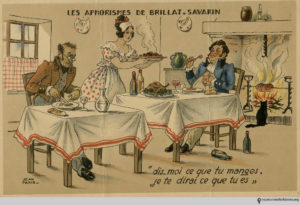
Iron Chef host Takeshi Kaga
By Thomas Parker, regular contributor
Iron Chef host Takeshi Kaga, who was more than a little enamored with the French nineteenth-century food writer Brillat-Savarin, is known to have re-popularized the latter’s famous statement “Tell me what you eat, and I will tell you what you are.”
In his nineteenth-century Physiology of Taste, Brillat-Savarin associated the act of eating with the most common verb of the language: être (to be). Eating transformed the eater, he claimed, as the power of nature held in food shaped through the art and science of cuisine not only sustains us, but actually shapes who we are. Brillat-Savarin, who was both a chemist and a physician by training, sounded a call to arms to chefs and eaters alike to combine ingredients, science, and taste for refined healthy eating and good living.

One of many of Brillat-Savarin’s aphorisms
One hundred and fifty years earlier, during Louis XIV’s reign in the seventeenth century, circumstances were appreciably different: food was much less associated with being than seeming. In a world of shifting social hierarchies, where rich bourgeois who weren’t born into aristocracy could buy noble titles, power was derived from merely appearing to be closely associated with the king and the splendor of Versailles. According to the prevailing wisdom of the time, it was more important to “paraître” (seem) than “être.”
Hippocratic and Galenic theories of medicine based on humors held over from the Renaissance encouraged this trend by suggesting that people with pure and delicate constitutions should gravitate toward foods with those same qualities. The connoisseur (usually self-pronounced) abided, eating with distinction and making a show of being able to discern flavors and foods that those with less pure constitutions would ignore. Instead of “you are what you eat,” the elegant proclaimed that you should “eat what you are.” One favorite for such aesthetes was white river veal from Normandy. Another was the Champagne of the town of Ay, known for its gustatory delicateness and ethereal purity. Using these foods and others, eaters attempted to perform class at the table, climbing the social ladder to achieve status in a world where seeming trumped being.

Veal from Normandy remains a specialty today
Since the time of Louis XIV and Brillat-Savarin, seeming and being have both remained relevant and evolved as the act of eating takes on new meanings in both France and the United States. To take one example, the famous physician and Harvard professor Leon Kass reversed Brillat-Savarin’s dictum in recent years. For Kass, human beings are at the top of the food chain and exert their dominance over the natural world at the table. We are not what we eat, but rather what we eat becomes us as we break it down and transform it into our bodies. In so doing, humans demonstrate their physical and symbolical dominance over the natural world, overcoming it in an experience repeated thrice daily.
This antagonistic relationship with food is rich with significance that arises in other contexts. Anthropologists have noted, for example, that culinary tourism contains elements that go beyond both sustenance and satisfying intellectual curiosity about foreign cultures to extend into paradigms of domination. We symbolically cannibalize the places and peoples we encounter by ingesting their wares. The stranger and more challenging their foods are, the more triumphant we feel when we imbibe them at the table.
A final relationship of note is more about dreaming than overcoming, seeming or being. Writing about the current popular trend of snout-to-tail eating, anthropologist Brad Weiss conveys that these whole-animal eating occasions are as much holistic as “wholistic” oriented. Eaters used to eat “high on the hog,” seeking out meat such as tenderloin, that was easier to disassociate from the animal. This allowed them to separate themselves from the animal world and elide the brutality of the carnivorous act because uniform nondescript pieces of meat packaged in shrink wrap under fluorescent supermarket lights no longer resemble the animal they come from.
Snout-to-tail eaters seek the opposite: in an act somewhat reminiscent of sacrificial rituel, they try to appropriate the animal, consuming the conspicuous innards and organs to remind themselves they are interacting with a being that once lived. In doing so, they are not looking to dominate nature, rather to reconnect with the idealistic life and free-range pastoral experience they imagine the animal to have lived. In eating, they are dreaming of leaving behind a humdrum, exhausted planet and a food system driven by markets, machines, and industrialized anonymity to find an identity in a perfect, green world. They no longer use food to know what they are, but to escape from what they’ve become.

